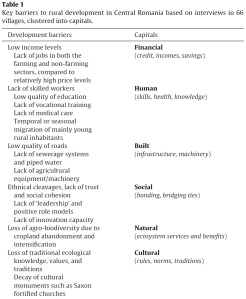In an increasingly globalized world, rural areas are confronted with enormous development challenges. Agriculture, and in particular smallholder farming, often provides the backbone of rural livelihoods, but the future viability of this sector is threatened by a rising integration of rural areas into the global economy, and thus an increasing exposure of primary product markets to liberalized trade regimes. As a result, rural residents often need to diversify their incomes, specialize, or shift away from traditional farming activities – a set of changes that is closely linked with the notion of rural development. Several models of rural development have been proposed, but they do not always adequately explain why development stagnates in certain regions.
In our new paper we provide a possible explanation for such stagnation, illustrated by a case study from Central Romania. Based on qualitative interviews with over 350 inhabitants from 66 villages, our aim was to understand the barriers to rural development of this region or social-ecological system, respectively, and to suggest levers to move it into a more desirable state. To this end, we combined the concept of traps with the sustainable livelihoods approach. In short, the traps concept depicts the dynamics across spatial, organizational, and temporal scales in creating undesirable system states that are difficult to overcome. The sustainable livelihoods approach, in turn, analyzes at the household or community level how different combinations of livelihood assets correspond to alternative livelihood strategies. Livelihood assets or ‘capitals’ are typically built capital (e.g. infrastructure); natural capital (e.g. land, trees); human capital (e.g. education, health); financial capital (e.g. incomes, savings), and social capital (i.e. bonding and bridging ties within and between people, communities, or organizations). The notion of cultural capital is sometimes used in addition, referring to specific values, world views, and (ecological) knowledge transmitted within a community.
To our mind, the combination of the sustainable livelihoods approach with traps theory had a series of useful advantages. With the notion of capital assets, the sustainable livelihoods approach served to differentiate between different types of barriers to rural development, while the systems approach was useful to highlight interdependencies between various barriers. So what we did was to cluster potential development barriers, identified by rural inhabitants, into different kinds of livelihood capitals (see Table). We then looked at the interaction and feedbacks between these capitals, as well as the role of the institutional context.
Our empirical findings suggest that Central Romania is subject to a multitude of rural development barriers, associated with a lack or endangerment of various different types of capital assets. Moreover, our findings indicate that development barriers are often interacting and mutually reinforcing, which in combination seem to keep Central Romania trapped in an undesirable state characterized by poverty, outmigration, and severe risks to farmland biodiversity. While the region’s natural and cultural capitals stand the best chances to foster rural development, they are likely to deteriorate, too, unless other capitals – financial, social, human, and physical capitals – are also developed at the same time. The development of capitals, in turn, is strongly influenced by the institutional context, which according to our results is in need of improvement. Given the interconnectedness of barriers, we doubt that big-push economic interventions alone would successfully ‘unlock’ the trap-like situation of Central Romania. To our mind, such measures could even be counterproductive. Instead, we recommend that policy interventions tackle various capitals at the same time, ideally leading to positive feedbacks across multiple types of capitals.
While this paper focused on Central Romania, we believe our approach could offer a fruitful, new way of framing rural development research, and to develop appropriate policy strategies.
Recommended citation:
Mikulcak, F., Haider, J.L., Abson, D.J., Newig, J. & J. Fischer (2015), Applying a capitals approach to understand rural development traps: A case study from post-socialist Romania, Land Use Policy 43: 248–258.


Reblogged this on Jamila the Lorax’s Blog and commented:
New Paper: Applying a capitals approach to understand rural development traps. Check out reflections from the Ideas for Sustainability blog, or download our paper: http://www.sciencedirect.com/science/article/pii/S0264837714002415
Reblogged this on AgroEcoPeople and commented:
Great work by my friends and colleagues based (mostly) in Germany.
Thanks for reblogging!!